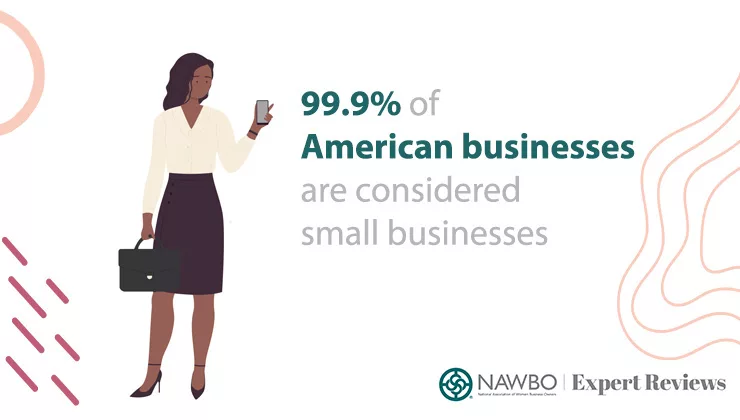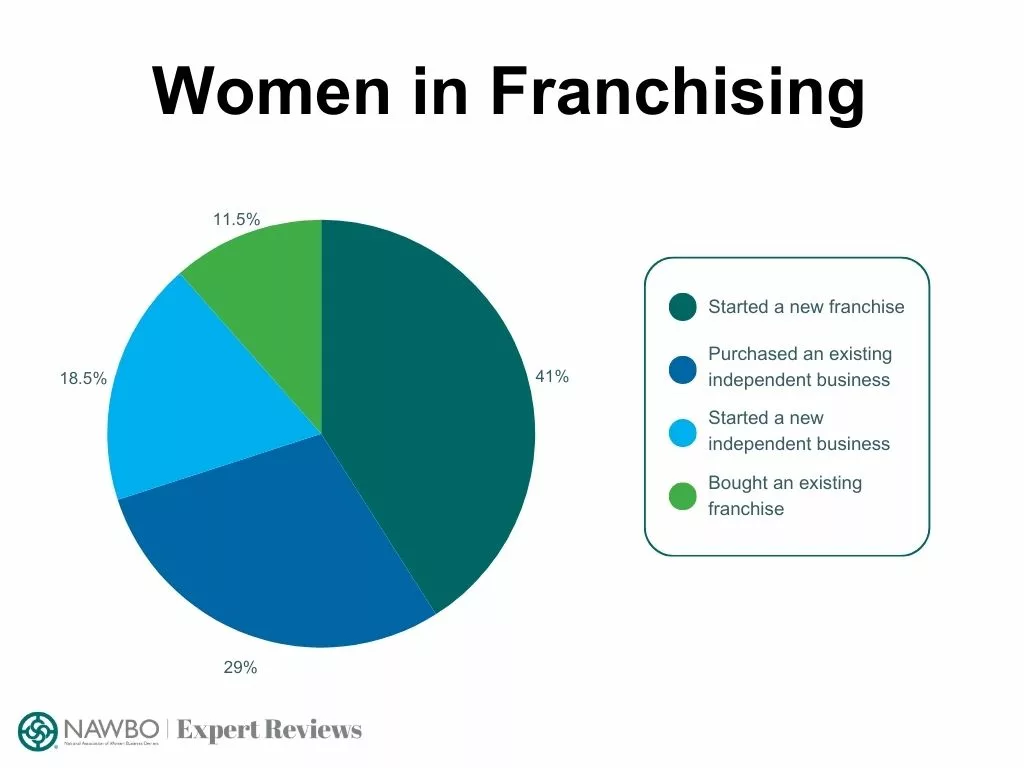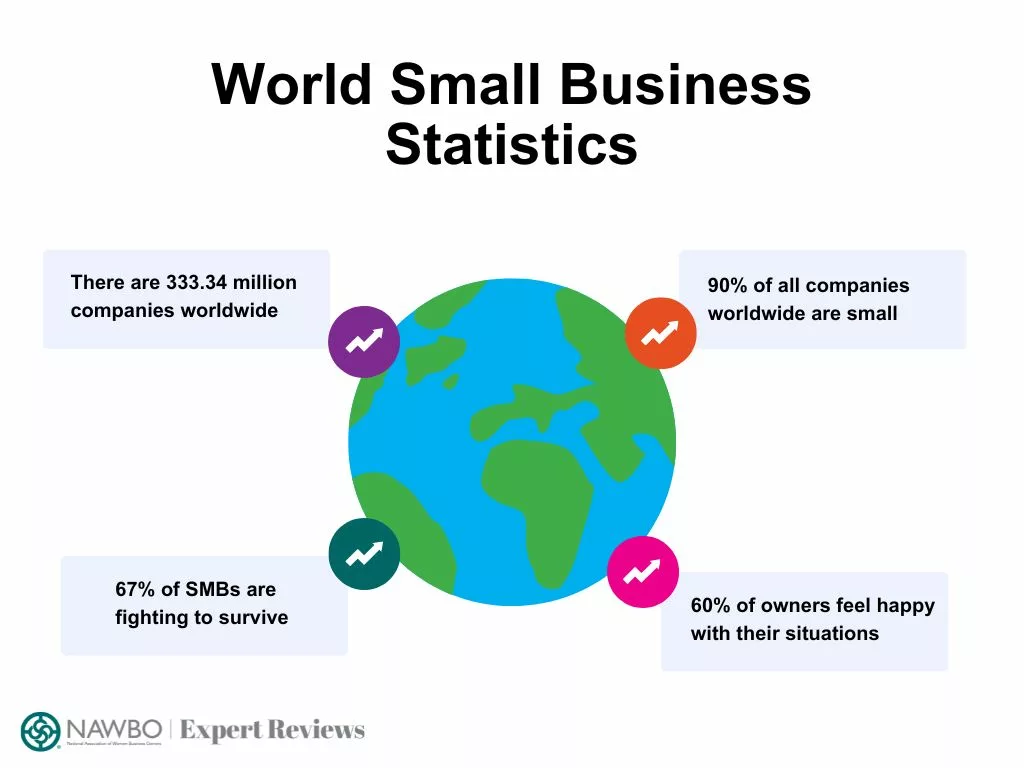What Percentage of Businesses are Small Businesses?
Fact Checked
For entrepreneurs and investors, it’s wise to understand the current landscape of small businesses. Knowing which businesses and industries are thriving can inform decisions on where to invest. It also highlights gaps in the market or areas of high competition, which can help those interested in founding their own startup.
Below we break down the most recent statistics to see what percentage of businesses are small, what percentage of them are owned by various demographics, and the industries where small businesses are most common.
Key Takeaways:
- 99.9% of American businesses are considered small businesses.
- 84.8% of establishments in rural areas are small businesses.
- 43.2% of all small businesses are owned by women.
- 20% of employer businesses are owned by minorities.
- 90% of all companies worldwide are small businesses.

Percentage of Small Businesses in the U.S.
The U.S. Small Business Administration defines a small business as an independent business with fewer than 500 employees. As it turns out, the vast majority of the 33.2 million businesses in the United States are small businesses, each employing somewhere between 1 and 499 employees, creating new jobs and opportunities for many workers in America.
- 99.9% of American businesses are small.
- Small businesses employ 46.4% of U.S. workers.
- 59.9 million Americans work at small businesses.
Small businesses are located throughout the country, but some states have higher concentrations of small business employment while others have less:
- Vermont, Wyoming, and Montana have the most, with 60% of their workforce being employed by small companies.
- Nevada, Tennessee, and Florida have the least, with 43% of their workforce being employed by small businesses.
Similarly, small businesses play a big role in rural areas. In fact, the majority of establishments and employment in rural communities come from small businesses.
- 84.8% of establishments in rural areas are run by small businesses.
- These establishments employ 54.3% of workers in rural areas.
Small businesses are critical to rural communities, yet the rate of rural small business employment has grown slowly over the last decade compared to large businesses. According to the U.S. Small Business Administration (SBA):
- Between 2012 and 2019, rural small business employment grew by only 1%, while employment for large rural businesses grew by 12.9%.
Despite employing a higher number of employees per capita, rural small business employment growth remains significantly behind the growth rate of rural large business employment.
The Rise of Franchising in Small Business
Small businesses help the U.S. economy through ecommerce, consistent job creation, and steady cash flow. However, the small business failure rate is consistent, and some entrepreneurs are looking for lower-risk, tried-and-tested ways to run a business.
Franchises offer business owners the advantage of a proven business model, brand recognition, and support, reducing the risk and uncertainty often associated with starting a new, independent company.
- The U.S. Census Bureau states that around 11.4% of all establishments are franchises.
Franchising has grown in popularity in recent years. The number of franchisees has increased by 12% since last year. Guidant Financial recently surveyed existing franchise owners and found that:
- 35% of respondents chose to open a new franchise location.
- 11% of respondents chose to buy an existing franchise.
They also found that women are more likely to open franchises than independent businesses in recent years:
- 41% of women started a new franchise.
- 29% of women purchased an existing independent business.
- 18% of women started a new independent business.
- 11% of women bought an existing franchise.

This study shows that in addition to opening their own business, women entrepreneurs are embracing the diverse benefits offered by franchising. Especially during times of economic uncertainty, the benefits of franchising can possibly improve the success rate.
Percentage of Small Businesses Owned by Women
Women’s entrepreneurship has grown significantly over the past decade. In what was once a field where only men could thrive, women are forging their own path through business and ownership. In fact, in 2022, women created about half of the new businesses in the U.S. for the third year in a row. While pre-pandemic, they only started around 29% of new businesses.
- Women own around 43.2% of all small businesses.
- That’s nearly 13 million businesses (employer and nonemployer firms).
- Additionally, women-owned businesses employ over 10.1 million workers.
Creating and maintaining a business takes ample amounts of time and effort. As such, it is no surprise that most women business owners are from generations that have had more time to grow their businesses. The majority of female business owners belong to the Gen X and Boomer generations.
- 55.7% of female business owners are part of Gen X.
- 29.9% are part of the Boomer generation.
- 14.4% are Millennials.
Additionally, while many women-owned businesses are run by Caucasian women, the number of Black women business owners has increased in recent years. Guidant Financial found that:
- 78.4% of women business owners are Caucasian women.
- Black women-owned businesses increased by 33% from 2022 to 2023.
Women own both employer firms and nonemployer firms. A nonemployer firm does not have any paid employees.
- 10.9 million women-owned businesses are without employees, according to SCORE.
- These companies now comprise 41% of all nonemployer firms in the country.
While women-owned businesses are increasing in the United States, they still face many difficulties and discrimination in many areas. In 2022, Americans filed about 5.1 million business applications and many sought small business loans.
- 25% of women had their loan applications denied.
- Only 19% of men were rejected.
- Over the past five years, 74% of women-owned firms relied on personal savings, friends, or family funds to support their business operations.
- Only 64% of male-owned businesses did the same.
Similarly, women of color are more likely to self-fund their businesses. Unfortunately, this makes them more vulnerable to financial risk. These struggles affect how many women feel about the health of their business.
- Only 47% of women feel their business is in “somewhat or very good” condition, while 62% of male business owners think that way.
Women also reported feeling more concerned about revenue increases than men. As such, women plan to make fewer business investments and hire fewer people.
Minority-Owned Small Business Statistics
Other demographics are venturing into small business ownership more than ever. According to the most recent study by the U.S. Senate Committee, businesses owned by women of color are growing faster in 2023 than women-owned businesses in general.
- Black women created 42% of the newly created women-owned businesses.
- Latino women started 31% of these businesses.
Interestingly, 88% of Black-owned businesses are located in urban areas, making them available to many people.
The United States Census Bureau found that in 2020 there were a total of 5,775,258 U.S. firms in all sectors.
- Approximately 20% (1.2 million) of these employer businesses were owned by minorities.
- These businesses employed about 9.9 million employees.
- 5.6% of those companies were Veteran-owned.
Hispanic-owned businesses have also been increasing over the past decade. The U.S. Census Bureau’s 2021 Annual Business Survey (ABS) found that Hispanic-owned companies accounted for 6.5% of all businesses. This was an 8.2% growth from years before.
Yet, of minority-owned businesses, Asians own the largest number of small firms, with around 612,194 companies. They help with steady job creation as well, employing about 5.2 million workers in the United States.
Additionally, 27.5% of all Black-owned businesses are in the Health Care and Social Assistance sector.
Percentage of Small Businesses by Industry
There are a number of small businesses in every industry, but some sectors have a higher percentage of small businesses than others. To learn where concentration is the highest, the SBA’s Office of Advocacy conducted a study to see which industries have the most small businesses.
Below, we’ve compiled the findings, listing the top ten industries for small businesses. We organized it to show the total number of all small businesses in each industry, including employer and nonemployer businesses.
Most Common Industries for Small Business
| Industry | Total Small Businesses | Percentage |
|---|---|---|
| Professional, Scientific, and Technical Service | 4,594,752 | 13.85% |
| Other Services (except Public Administration) | 3,554,298 | 10.71% |
| Construction | 3,483,077 | 10.50% |
| Real Estate and Rental and Leasing | 3,268,764 | 9.84% |
| Transportation and Warehousing | 3,051,341 | 9.19% |
| Administrative, Support, and Waste Management | 2,946,753 | 8.88% |
| Retail Trade | 2,734,304 | 8.24% |
| Healthcare and Social Assistance | 2,723,766 | 8.21% |
| Arts, Entertainment, and Recreation | 1,700,200 | 5.12% |
| Accommodation and Food Services | 1,048,567 | 3.16% |
The majority of small businesses fall under the professional, scientific, and technical service industry, which perhaps is no surprise given the increase in technology and growing interest in STEM fields.
However, when we look at women business owners, we see a shift in which industries are most common.
- Women own around 215,779 businesses in the healthcare and social assistance sectors.
- They own 207,436 companies in professional, scientific, and technical services.
- Women own about 136,740 employer firms in the retail trade industry.
- They own 113,687 companies focused on services that aren’t part of public admin.
- Finally, the accommodation and food service industry is the fifth largest, with about 109,814 women-owned companies.
Small businesses employ nearly half the American workforce and are the main source of employment in many industries. In fact, in many driving industries in America, more than one-third of employees come from small businesses.
- 44% of workers in the healthcare and social assistance sector are employed by small businesses.
- 64% of the food and beverage sector workforce comes from small businesses.
- 82% of workers in the construction sector are employed by small businesses.
- 83% of employees in the agriculture, forestry, fishing, and hunting industry are hired by small businesses.
Percentage of Small Businesses Worldwide
Small businesses may make up the vast majority of companies in the United States, but they also make up a large portion of businesses throughout the world.
Statista estimates that there are approximately 333.34 million companies worldwide. And, according to the World Economic Forum:
- 90% of all companies worldwide are small.
- 70% of both jobs and gross domestic product (GDP) worldwide come from these small businesses.
However, despite being populous and beneficial for the world economy, small businesses fail frequently. According to the World Economic Forum:
- 67% of small and mid-sized companies are fighting to survive.
Despite this struggle, more than 60% of business owners report feeling happy with their situations. In fact, 33% report feeling “very happy” and 30% are “somewhat happy.”

The average small business owner and those who are their own boss face many challenges. In order to maintain a positive outlook and pursue your goals, you need to be self-motivated, have a growth mindset, and self-belief in your abilities.
The Bottom Line
New small businesses are created almost every day; therefore, it is no surprise that 99.9% of U.S. businesses are small businesses. On top of that, these companies employ 46.4% of the American workforce. Small businesses are vital to the health of the economy and the livelihood of many people, and it is important for consumers to support them.
Only 80% of businesses survive their first year, and nearly half fail by their fifth year, but there are ways you can impact your survival rate. You can take advantage of tools like social media, local SEO services, digital marketing, and project management software. You can establish clear collaboration and communication in the workplace. While these won’t guarantee success, they will certainly benefit your business.
Whether you are a seasoned business owner or an aspiring entrepreneur, you should consider these trends and opportunities when making your next entrepreneurial or investment decision.
About NAWBO Expert Reviews
NAWBO Expert Reviews is a free resource with reviews of software and services to help your business succeed. Our team offers their expert perspectives to ensure that small and medium-sized business decision-makers can find the best tools to help their business succeed.
Fair Use Statement
Feel free to share our research for any non-commercial purpose and provide your readers a link to this article so they can appreciate our full findings.
How to Cite this Article
NAWBO Expert Reviews. “What Percentage of Businesses are Small Businesses?” NAWBO.org. Feb. 9th, 2024, https://nawbo.org/expert-reviews/percentage-of-small-businesses/.


